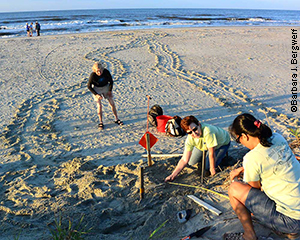In This Issue
By Amy Nelson
Jessica Norris reviews the book Voyage of the Turtle: In Pursuit of the Earth’s Last Dinosaur by award-winning author and marine conservationist, Carl Safina.
We shine Leaf Litter’s nonprofit spotlight on the oldest sea turtle conservation organization, the Sea Turtle Conservancy.
There are many ways you can help further sea turtle conservation. One is to volunteer to help local agencies find and protect sea turtle nests and eggs.

Find out what it is like to spend your early morning hours volunteering to help protect sea turtle nests and how important that donated time is to sea turtle conservation.
Grant Jones, founder of the firm Jones & Jones and recent recipient of the first-ever LAF Medal for distinguished work in applying the principles of sustainability to landscapes, shares some of his ocean-inspired poetry.
We encourage you to learn more about sea turtles by exploring our list of Resources.
We share some exciting news about the latest Biohabitats Projects, Places, and People.
Sea turtles have existed for over 110 million years, and they are the most migratory creatures on Earth, so they know how to adapt to changing conditions. But in the short time we humans have been around, our actions have caused them to suffer severely.
The longevity of these animal is just one of many things that make them such fascinating creatures. There are seven species of sea turtles in the world, ranging in size from the Kemps ridley, which typically measures around 24 inches long and weighs up to 100 pounds, to the massive leatherback, which can grow up to eight feet in length and weigh up to 2,000 pounds.
Sea turtles migrate hundreds or thousands of miles, following warm currents containing their food sources and often crossing or encircling entire oceans. The only exception is the flatback turtle, whose range is limited to the coastal waters of Australia and Papua New Guinea. Female sea turtles come ashore to lay their eggs. Some nest many times per season; some, like the olive ridley, may nest only twice each season. For most species, a single clutch contains 80–120 eggs. Once the female nests, she re-enters the water, leaving her eggs buried in the sand behind her as she resumes her migratory journey.
What is being done to protect sea turtles? How much do we really know about these long-lived, mysterious animals? What can we, as practitioners of ecological restoration, conservation, and regenerative design, do to better protect sea turtles and their habitats?
We also hear from three NOAA Fisheries experts who are actively involved in the protection of sea turtles under the Endangered Species Act.
Jessica Norris reviews the book Voyage of the Turtle: In Pursuit of the Earth’s Last Dinosaur by award-winning author and marine conservationist, Carl Safina.
We shine Leaf Litter’s nonprofit spotlight on the oldest sea turtle conservation organization, the Sea Turtle Conservancy.
There are many ways you can help further sea turtle conservation. One is to volunteer to help local agencies find and protect sea turtle nests and eggs.
Grant Jones, founder of the firm Jones & Jones and recent recipient of the first-ever LAF Medal for distinguished work in applying the principles of sustainability to landscapes, shares some of his ocean-inspired poetry.
We encourage you to learn more about sea turtles by exploring our list of Resources.
We share some exciting news about the latest Biohabitats Projects, Places, and People.
